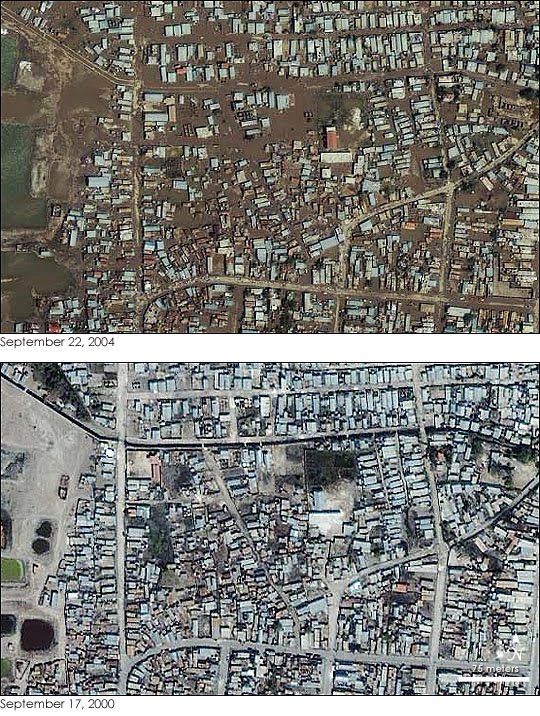15 January 2010
Why the Haiti earthquake takes us into new territory for disaster response
Posted by Dave Petley
The Haiti earthquake rightly continues to dominate the news around the world, with the situation on the ground looking increasingly desperate. The news media are already reporting on the growing frustration amongst the population about the lack of aid, not uncommon in large disasters actually, but probably magnified in this case. Although every rapid onset disaster is different, in a number of ways this event takes us into new territory. This will make the short, medium and long term mitigation of this event very difficult. These are the key issues as I see them:
1. Haiti has no army – and therefore effectively no national capacity to deal with the immediate aftermath
In recent years we have seen large earthquakes in other less developed countries – Kashmir in 2005 and Sichuan in 2008 spring to mind. In both cases, as is generally the case, the immediate response is framed by the national army, who undertake the initial rescue and logistics operations, followed quickly by the international organisations and agencies. Once the immediate rescue phase is over the army usually plays a key role in co-ordinating the response, in particular with the logistics of getting medical aid, food, water and sanitation to the people who need it. Haiti has no army – the military was demobilised in 1995. This is a key factor in the lack of coordination that you can see in the television pictures.
2. The earthquake struck the capital city
Point 1 is hugely exacerbated by what was in effect a direct hit on the capital city. It is clear that many government buildings collapsed and many civil servants were killed. In addition many of the key staff from international agencies were also killed. In a moment a huge component of the in-country organisational capacity was destroyed. This was not the case in other comparable disasters, where the national capability remained intact.
3. Population concentration is a key issue
The earthquake has struck a very densely populated urban area. Port-au-Prince is a natural amphitheatre in which almost all usable level ground has been quickly developed. Finding space to locate large refugee camps and medical facilities will be a great challenge.
4. Haiti is on a key hurricane track
I have used the NOAA Historic Hurricane Track viewer to produce the map below, which shows the hurricanes that have passed within 200 km of Port-au-Prince in the period since 1980:
 You will probably have noticed that there are a worryingly high number. Hurricanes bring strong winds, storm surges and, more importantly in this context, very intense rainfall. A direct hit from a strong hurricane would be exceptionally hazardous for those in temporary camps, would test damaged drainage systems, and could trigger extensive landslides (especially mudflows) on slopes weakened by the shaking.
You will probably have noticed that there are a worryingly high number. Hurricanes bring strong winds, storm surges and, more importantly in this context, very intense rainfall. A direct hit from a strong hurricane would be exceptionally hazardous for those in temporary camps, would test damaged drainage systems, and could trigger extensive landslides (especially mudflows) on slopes weakened by the shaking.
The hurricane season starts on 1st June (less than five months away). This is going to place an extraordinary level of urgency on operations over the next few months. Unfortunately, the December forecasts (which do have a comparatively low level of skill) for the 2010 hurricane season suggest that we should expect an above average season:
“We foresee an above-average Atlantic basin tropical cyclone season in 2010 and anticipate an above-average probability of U.S. and Caribbean major hurricane landfall.” For Haiti, the Caribbean and C. America Landfalling Hurricane Probability Project estimates that there is a 49% probability of a named storm tracking within 50 miles.
Synthesis
Given the above, I suspect that there will be a need for the international community to direct considerable resources into Haiti over a prolonged period. I wonder whether this will be possible as the story fades from the news screens, and given the pressure on western government budgets at present.
Landslide potential in the aftermath of the earthquake
Finally, a word on the future landslide potential. In a nutshell we just don’t know what will happen and, whiteout proper field investigations, including mapping and modelling, there is no way to estimate the likely future effects. It may be that there will be a large number of slides in the first very heavy (probably hurricane-induced) rainfall event, or it could be that there will be no more than usual. Note here in recent years these have killed hundreds and even thousands of people, but mostly in the area around Gonaives, not Port-au-Prince. The image below, from here, shows a before and after IKONOS satellite image of Gonaives in the aftermath of Tropical Storm Jeanne in 2004. The mud was released by landslides on the hills above the town. Over 3000 people died.
 I must stress here that at present we have no way of knowing whether this could happen in the earthquake affected area or not. This requires attention with some urgency.
I must stress here that at present we have no way of knowing whether this could happen in the earthquake affected area or not. This requires attention with some urgency.


 Dave Petley is the Vice-Chancellor of the University of Hull in the United Kingdom. His blog provides commentary and analysis of landslide events occurring worldwide, including the landslides themselves, latest research, and conferences and meetings.
Dave Petley is the Vice-Chancellor of the University of Hull in the United Kingdom. His blog provides commentary and analysis of landslide events occurring worldwide, including the landslides themselves, latest research, and conferences and meetings.